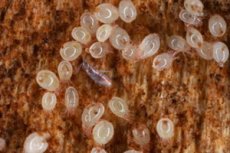New publications
New study reveals how dust mites cause allergic asthma
Last reviewed: 02.07.2025

All iLive content is medically reviewed or fact checked to ensure as much factual accuracy as possible.
We have strict sourcing guidelines and only link to reputable media sites, academic research institutions and, whenever possible, medically peer reviewed studies. Note that the numbers in parentheses ([1], [2], etc.) are clickable links to these studies.
If you feel that any of our content is inaccurate, out-of-date, or otherwise questionable, please select it and press Ctrl + Enter.

Researchers at the University of Pittsburgh have discovered how inhaling house dust mites, a common cause of allergic asthma, activates the immune system and promotes the disease in mice. The findings, published in the journal Nature Immunology, provide new insights into how seemingly harmless substances such as dust mites, animal dander, and pollen can trigger allergic reactions. These discoveries could lead to new treatments and management of allergic asthma.
Main results of the study
Tolerance and immune system dysfunction:
- The immune system usually distinguishes harmless substances from pathogens, but when "tolerance" fails, T-helper type 2 (Th2) cells are activated, causing the inflammation characteristic of allergic asthma.
- Allergic asthma is the most common form of asthma and causes symptoms such as cough, chest tightness, shortness of breath and wheezing.
Mechanism of Th2 cell activation:
- The study was conducted on a mouse model where asthma was induced by inhalation of dust mites, which more accurately reflects natural human exposure to allergens.
- A specific molecular pathway involving the protein BLIMP1 has been identified that is required to activate Th2 cells in the lymph nodes. These cells then migrate to the lungs, causing disease.
The role of cytokines IL2 and IL10:
- It turned out that two signaling molecules, IL2 and IL10, are necessary for the expression of BLIMP1.
- IL10, commonly known as an anti-inflammatory cytokine, unexpectedly promoted inflammation.
Practical conclusions
Potential targets for treatment:
- The discovery of the role of IL10 as an inflammatory factor opens up new therapeutic possibilities, especially for early intervention in patients with newly diagnosed allergic asthma.
- Most patients receive steroids, which relieve symptoms but do not address the cause of the disease, highlighting the need for new treatments.
IL2 Activity Map:
- The researchers found that IL2 activity was localized to specific "hot spots" in lymph nodes. These areas may be key to understanding the formation of Th2 cells and the potential for suppressing asthma by destroying them.
Next steps
- In collaboration with colleagues from the Department of Pulmonology, Allergy and Sleep Medicine, the researchers plan to study lung tissue samples from patients with allergic asthma to confirm the role of IL2 and IL10 in Th2 cell activation.
- These studies may lead to the development of new therapeutic approaches aimed at early intervention and prevention of long-term airway damage.
Financing
The study was supported by the National Institutes of Health (NIH), the Lung Association, the Children's Hospital of Pittsburgh Scientific Advisory Committee, and a Clinical and Translational Science Institute Pilot Award.
